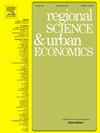空间工资差异、地理摩擦和企业内部的劳动力组织
IF 3.5
2区 经济学
Q1 ECONOMICS
引用次数: 0
摘要
本文从理论和实证两方面对企业的空间组织进行了研究。丹麦注册数据中的两个新事实促使了分析:(i)公司在空间上变得越来越分散,(ii)总部(HQ)机构变得更加经理密集。我们开发并估计了一个结构模型,在这个模型中,公司在各个机构之间分配劳动力,并提供非竞争的、经理密集型的总部服务。识别依赖于通勤增强移民冲击引起的劳动力供给的外生变化。我们估计,企业的替代弹性对工人为- 9.8,对管理人员为- 1.1,这与企业重新分配一般劳动力比重新分配管理投入更容易一致。我们的分解表明,总部管理人员工资的上升——与公司层面的规模效应相互作用——解释了所观察到的总部管理强度增加的一半左右,突出了无形的内部投入在塑造公司空间结构中的重要性。本文章由计算机程序翻译,如有差异,请以英文原文为准。
Spatial wage differentials, geographic frictions and the organization of labor within firms
This paper studies the spatial organization of firms, both theoretically and empirically. Two new facts in Danish register data motivate the analysis: (i) firms have become increasingly spatially fragmented, and (ii) headquarters (HQ) establishments have become more manager-intensive. We develop and estimate a structural model in which firms allocate labor across establishments and produce non-rival, manager-intensive HQ services. Identification relies on exogenous variation in labor supply induced by commuting-augmented immigration shocks. We estimate elasticities of substitution across establishments of −9.8 for workers and −1.1 for managers, consistent with firms reallocating general labor more easily than managerial inputs. Our decomposition shows that rising managerial wages at HQs – interacted with firm-level scale effects – explain about half of the observed increase in HQ managerial intensity, highlighting the importance of intangible internal inputs in shaping firm spatial structure.
求助全文
通过发布文献求助,成功后即可免费获取论文全文。
去求助
来源期刊

Regional Science and Urban Economics
Multiple-
CiteScore
5.30
自引率
9.70%
发文量
63
期刊介绍:
Regional Science and Urban Economics facilitates and encourages high-quality scholarship on important issues in regional and urban economics. It publishes significant contributions that are theoretical or empirical, positive or normative. It solicits original papers with a spatial dimension that can be of interest to economists. Empirical papers studying causal mechanisms are expected to propose a convincing identification strategy.
 求助内容:
求助内容: 应助结果提醒方式:
应助结果提醒方式:


